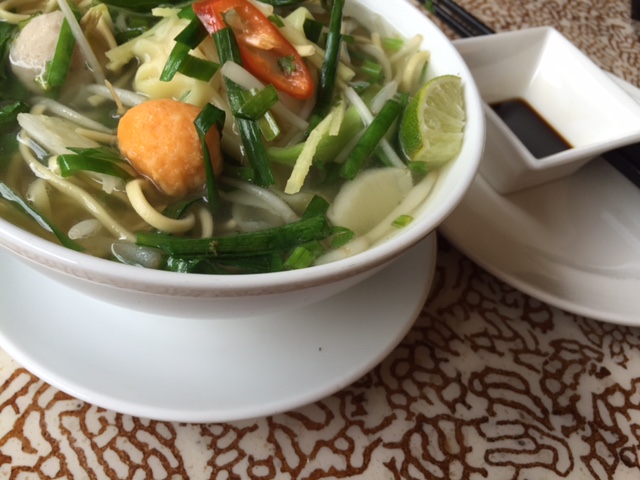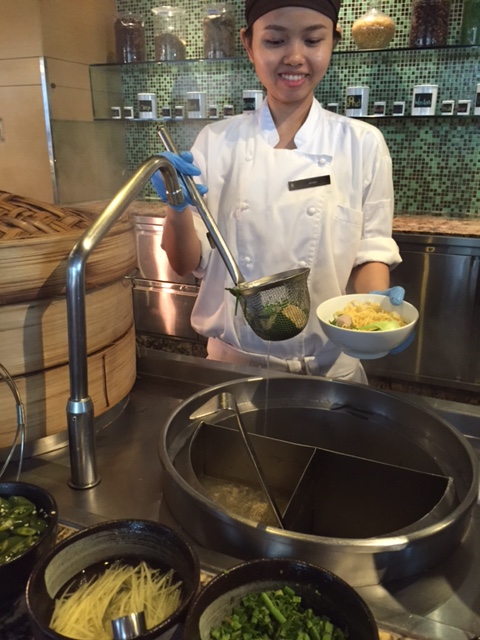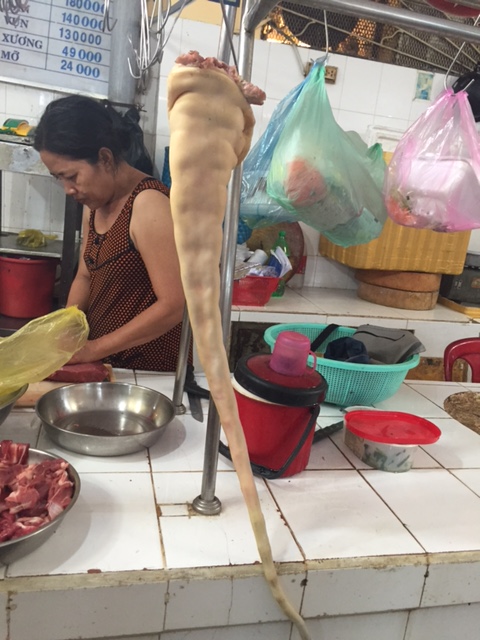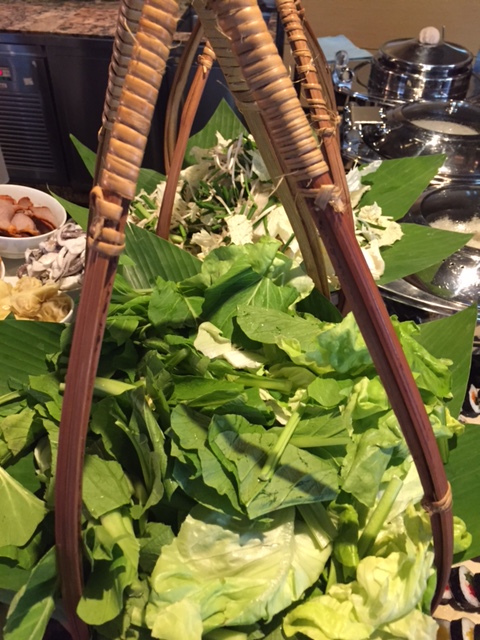This cuppa was with Eric Fettke he shared his insights into Bun Cha that he often shares with friends when in London and the lucky diners of the InterContinental Hotel, Asiana Saigon Ho Chi Minh City, Vietnam; where he works as Executive Chef. He kindly shared with me not only a few of his favourite noodle recipes he shared with me some of his likes and loves of noodles which he has accumulated over time living in Danang, Hanoi – Vietnam, Joburg – S.Africa, Poland and Aqaba – Jordan.
Discussing interesting dishes noodle soup based, Chef Erics favourites are: Bun Cha and the Cha Ca both from Hanoi. Whilst I traveled through the South of Vietnam through Saigon, Mekong Delta and Hoi An I sought out tasty noodle soups so we swopped many stories of tasty soups and his favourites and he shared some recipes.
The Bun Mien made from rice flour which is fantastic to watch being made as the cooks will use a cloth with holes in squeezing it into the water – obviously there are some big machines also used but this way it can be made to the quantity needed, squeezed into the hot water and then it is scooped out and used after 2 mins cooking and when it rises scoop them out. Unlike the Chinese process of where they pull the noodles the Vietnamese noodle process is quite different.
The Bun Cha would be with the rice noodle and served with two types of pork (pork belly and the pork shoulder that has been ground into patties that have been marinated with onion, lemongrass, chili, black pepper and fish sauce. The marinade would be the same for both and the meat would be cooked on charcoal to give a smokey flavor and caramelise.
There are two ways of eating noodles either dry or wet.
You would eat the Bun Cha in three ways:
(i) A bowl of wet noodles (ii) A bowl with room temperature stock (Bun Cha water which is a base made up of fish sauce and water, garlic and corabean carrot, all cooked together to make a sweet and spicy. (iii) A bowl of Vietnamese basil, parilla leaves, shredded lettuce.
So you basically add the noodles to the stock, which has the meat inside, and you take some of the herbs and eat it like that.
In the North of Vietnam this would be served with a fried spring roll, and inside they would have the same type of noodle, with minced vegetables, Vietnamese black fungus mushrooms, all deep fried and the spring roll will go into the stock. So as you eat it intensifies the flavours which is lovely and probably the number 1 dish.
The Cha Ca also uses the Bin Mien rice noodle. It is a fish dish marinated with galangal, fresh turmeric root, chopped dill, cooked on the BBQ and while cooking add more dill and onions and finish it together with some fish cooking sauce and some toasted shallots and crushed peanuts.
So you would eat it by having your bowl of Cha Ca, eat with your fish together but it would be drier with the fish sauce being more of a dressing like soup.
Cha Ca – Check out Cha Ca La Vong an authentic restaurant in the old quarter of Hanoi – this is the most famous place in Vietnam, it is a very low key place so don’t expect fine dining crockery J – A bucket will be brought to the table filled with charcoal and you will make your own meal at the table. In Hanoi there are plenty of good Cha Ca places but this is probably the best for tourists.
The Bun Rieu from the Mekong Delta area is not one of Erics’ favourite dishes; it is made with the thicker noodles made from Tapioca and wheat flour, whilst the noodles are fine the stock has a lot of shrimp paste inside with tomatoes and pigs liver; the thing is Eric stressed the importance of knowing where the pigs liver came from and how it has been treated.
Mi Quang It is a very Chinese influenced dish with egg noodles served with either beef or seafood (Mi Quang Hi Son). Depending on where you eat it the dish will vary slightly in the South everything is sweeter. In the north the food seems to be a lot cleaner and nicer. What is very popular now is the noodles are deep fried with a thick sauce that is poured on top for you to enjoy which is really nice.
In Hoi An there is Cao lầu (my husband’s favourite noodle dish only found in Hoi An), is a must. As it is very different –it has a mix of influences from the Chinese and Japanese, urban legend has it that Cao lầu noodles derived from the Japanese Soba noodles as they use a flat noodle similar, this is flawed due to there being no buckwheat in the noodle. On the other hand some Chinese wheat noodles are similar to those used in Cao lầu though made with rice flour. Traditionally this noodle soup is made with sliced pork (Cha Siu), local greens, including Vietnamese mint and the best thing about this soup is that it has a wonderful crunch added with rice crackers sprinkled on the top. new restaurants with modern versions have added shrimp or chicken, and additional herbs. And the pork broth is sometimes blended with dried shrimp/squid or chicken stock. The only consistent item are the noodles. So if you see Cao lầu noodles, then you have Cao lầu.
Pho (pronounced Fur), which is the Vietnamese national dish. Chef Eric mentioned Pho’s point of difference is like ‘chicken soup for the soul’. In the north and south it is very different. In the north it has more chicken flavor and has chicken fat on top and in the south. The trick to a good Pho is to almost burn the cinnamon with the ginger and put it on the BBQ and make it very dark and put it into the stock. In Saigon they will add black cardamom. In the north you would eat it with fresh chili and lime but in the south they add fish sauce, white pepper and black bean sauce, which takes away from the pure dish. In an hour you are often hungry. Whatever is left over is the base to make more with, so it keeps being topped up with fresh bones etc.,
Fried fish with turmeric, dill and rice noodles.
Ingredients: 300g Firm white fish, Small bunch spring onions cut julienne, Small bunch of dill roughly chopped, 300g Rice noodles fresh or rehydrated as per the packet instructions, Oil to fry
Marinade – Mix all together – 15ml Fresh turmeric chopped, 30ml Fresh ginger finely chopped, 15ml Sugar, 5ml Salt, 5ml Shrimp Paste, 15ml Rice vinegar, 300ml Nouc Cham, Roasted peanuts roughly chopped, Fried shallots, Chopped dill
Nouc Cham: 1 Red Thai chili finely chopped, 1 Clove of garlic finely chopped, 45ml Sugar, 125ml Water, 15ml Rice Vinegar, 75ml Fish sauce – Depends on the quality and strength, 10-15ml Lime juice. Mix all the ingredients together in a bowl. You can add finely sliced carrot and Kohlrabi in if you like, quite nice
Method: Cut the fish into cubes 2cm x 2 cm and place in the marinade. Rub in well and allow to marinade at least 4 hours.
In a hot pan, add enough oil to cover the base and fry the fish. Oil should always be a little more as this takes on the marinade and will be part of the dressing when you serve it. When 90% done add the spring onions and dill and remove from the heat.
Serve on a platter and add some of that lovely flavored oil, topped with the peanuts and serve the noodles and sauce separate bon the side. Noodles should be warmed slightly; dipping sauce can be room temperature. — Eric loves this dish and its super fast to prepare if your entire mise en place is ready.
Bun Bo Nam Bo (“Dry” Beef and Noodle dish)
Ingredients: 400g Beef – Use cheaper tenderloin of softer strip loin or even decent rump, 2 Pieces lemongrass – white only finely chopped, 2 Cloves garlic finely chopped, 30ml Fish sauce, 30ml Oil, 1 Small onion cut julienne, Bean Sprouts, White pepper, Salt, 400g Fresh rice noodles or rehydrated as per the packet instructions
Garnish: Crisp salad leaves – Lambs lettuce, Cos Lettuce, Fresh coriander, Fresh mint, Fresh Thai basil, Crushed roasted peanuts, Crispy fried shallots.
Nouc Cham with the addition of freshly crushed black pepper and a little extra dried chili
Method: Slice the beef strips into julienne and marinade the beef with half of the lemongrass, half the garlic and fish sauce.
In hot wok/pan sauté onions, the remainder of the garlic and the lemon grass, add the beef and sauté with the white pepper and a pinch of salt.
Place the noodles into a bowl, add some of the fresh herb leaves and salad leaves, next place the beef on top, dress with about 125ml – 150ml of the nouc cham and complete the garnish with more herbs, fried shallots, and roasted peanuts.
This dish is hot beef, warm noodles and warm dressing – Doesn’t need to be piping hot. You use the dressing in the bowl to coat the noodles and eat with the beef.
———————————————————————–
Bun Cha (Grilled pork 2 ways with rice noodles)
Ingredients: Small bunch of spring onions cut into rings, 2 Shallots finely dices, 30ml Caramel sauce (120g sugar caramelized in a pan, 80ml water added and removed from the heat, 1 Small onion, skin on and bashed with a pan – Now this move isn’t very common but the smashing of the onion which is still in the skin helps to tenderize and flavour the meat giving it something a little extra, Salt, White pepper, 200g Pork belly, sliced 3cm*3cm – thin strips, 200g Minced pork, 30ml Vegetable oil, 400ml Nouc cham, add the black pepper, kohlrabi and carrot, 400g Fresh rice noodles or rehydrated as per the packet instructions
Garnish : Crisp salad leaves – Lambs lettuce, Cos Lettuce, Fresh coriander, Perilla leaves, Vietnamese Basil leaves, Additional thinly sliced red Thai chilies, Bean Sprouts.
Method: To make the marinade mix the sliced spring onions, shallots, fish sauce, caramel, salt and white pepper in a bowl. Add the smashed onion and leave for 30 minutes pour half the marinade over the pork belly, keep the smashed onion with this and mix half with minced pork. Form small patties with the mince.
For the sauce, use the nouc cham add freshly crushed black pepper, carrot and Kohlrabi to the mix, warm through gently as not to upset the balance of sweet and salty. Grill the belly and patties until nicely caramelized.
To serve: Place the meat on a platter; give each person their own bowl of noodles, nouc cham and lettuce, herbs, sliced Thai chili and bean sprouts. To eat you place some of the noodles, herbs, lettuce, sprouts and meat into the bowl and eat it like you would any noodle dish adding more herbs, sprouts and meat as you go along.
———————————————————————–
Pho Bo: (National dish, beef broth with beef and herbs).
Ingredients :’ Here it’s all about the stock’. 600g Beef Knuckle bones, 300g Chicken carcasses, 300g Oxtail bones – if you don’t have then another 500g beef bones, 30g Star anise, 15g Cinnamon stick, 30g Whole ginger, 10g Maggie chicken powder, 15ml Fish sauce, 400g Fresh “Banh Pho” noodles or rehydrated as per the packet instructions, 200g Beef Brisket, :100g Beef tenderloin
To Garnish: Fresh coriander, Bean Sprouts, Julienne spring onion, Sliced red Thai chili, Thinly sliced onion julienne, Chili sauce, Lime wedges.
Method: Rinse all the bones well, bring to a simmer and skim off all of the scum and oil. Boil for 20 minutes until clean. While this is boiling place the cinnamon, onion, star anise and ginger under the salamander and give it a good heat to almost “burn” it. It should be starting to go black, careful, cinnamon and star anise need a lot less time than the ginger and onion. Place the clean bones in a pot with fresh water and any leftover stock that you might have from the previous batch of pho. Add the aromatics, a little magi powder and the fish sauce and allow to simmer for at least 12 hours. While this is simmering place the brisket into the stock and allow it to cook until done. Remove and cool, slice on a slicing machine. Strain the stock and keep warm, a couple of droplets of fat on top is perfectly acceptable.
Place the Banh Pho in hot water, strain and place into a bowl. Add the sliced beef brisket, some freshly sliced “raw” beef and next the stock to cover the meat. Top with sliced onions, julienne spring onions.
Serve the chili sauce and lime wedges separately for the guests to add, as they like.
———————————————————————–
Canh Chua Ca: (Fish in a sweet and sour broth with rice noodles)
Ingredients: 150g Tamarind pulp, 500ml Fish stock, 30ml Fish sauce, Pineapple slices 2cm x 2cm, 50g Sugar, Silver perch- Can use any other smaller meaty white boned fish but into round slices with the bone in – Steaks, 1 Tomato, skinned and de seeded, cut into 8 pieces, 10 Pieces okra, 400g Fresh rice noodles or rehydrated as per the packet instructions
To Garnish: 150g Bean sprouts, Crispy fried shallots, Fried garlic – Cut lengthways very fine and fried until crispy in about 160 degree Celsius oil, Chopped Thai red chili, Fresh coriander, Fresh dill.
Method: Dissolve the tamarind pulp in warm water, “massage it well” to ensure that all of the flavor is released. Strain well to remove all little bits and the seeds. Combine with the fish stock. Fish sauce, pineapple and sugar in a large pot. Add the tomato fillets and sliced okra and bring to a gentle simmer. Add the fish “steaks” and cook through. Remove the steaks. Place the noodles in bowls, top with the delicious broth making sure that each person gets tomato fillets and pineapple. Top with the fish steaks, bean sprouts, fried shallots, garlic, coriander and dill.
———————————————————————–
Goi Bo: (Beef, Mushroom and Glass Noodle Salad)
Ingredients: 200g sirloin or rump steak, 100g Glass Noodles, 10g Dried mushrooms – Wood Ear, Black Fungus etc, Fresh mint, Fresh Coriander, Fresh Basil, 2 Kafir lime leaves finely sliced, 2 Thai red chilis julienne, 1 Small red onion julienne, Half a cucumber, de seeded and sliced, 5ml Roasted rice powder
Marinade for the beef: 1 Clove of garlic crushed, 15ml Soya sauce, 15ml Fish sauce, 10ml Sugar, 5ml Sesame oil, Mix all the ingredients in a bowl together
Salad Dressing: 25g Grated palm sugar, 30ml Lime juice, 15ml Fish sauce, 15ml Soya sauce, 1 Clove of garlic, 5ml Chili oil, 10ml finely chopped lemongrass, 1 Small bunch fresh coriander, 30ml Oil, Place all the ingredients into a blender and blend
To Garnish: Roasted chopped peanuts, Fried shallots, Fresh mint, Fresh Coriander, Fresh Basil
Marinade the beef in a bowl in the fridge for at least 30 minutes, the longer the better really. Soak the glass noodles and mushroom sin warm water to rehydrate them, strain and place into a bowl. Cut the glass noodles into 4cm strips. Cook the steak, should be medium maximum unless it’s an issue, allow to rest and slice. We always prepared this in advance and just shaved the beef into very thin slices and placed onto a plate by the pass for 2-3 minutes. Mix the sliced beef with the rest of the ingredients and dress with just enough of the dressing to evenly coat the salad. Place in a bowl or plate and garnish with the fresh herbs, roasted peanuts and crispy shallots.
———————————————————————–
Bun Bo Hue: (Spicy beef and pork leg soup)
Sounds quite over powering but actually a unique brilliant taste. If you like cut back a little on the shrimp paste. It’s a labour of love but so worth it!!
Ingredients: 60ml Shrimp paste, 500ml Hot water, 1kg Pork Knuckle, 1kg Beef shin, 250ml Fish sauce, 2 Small onions sliced julienne, 4 Cloves of garlic crushed, 1 Cinnamon stick, 4 Cloves, 30ml Crushed black pepper, 1kg Oxtail, 2 Stalks lemongrass, 100g Rock salt
Garnish: 1 Small bunch spring onions, 2 Small bunches of mint, Bean sprouts, 400g Fresh rice noodles or rehydrated as per the packet instructions.
To Serve: Shrimp paste, Chili sauce
Method: Dissolve the shrimp paste in water and allow steeping for at least 2 hours, straining the liquid well. While this is steeping marinade the pork leg and beef shin in with 1 cup of the fish sauce for about 1 hour. Stir fry the onion and spring onion in a little oil for 2 minutes, remove and wrap in muslin cloth with the cinnamon, cloves and black pepper. In a clean pot place about 5 liters of water, the rock salt, remaining fish sauce and the oxtail and bring to the boil, skimming to remove the impurities. Once boiling, reduce to a simmer and leave to simmer for at least 30 minutes. Add the beef, pork, lemongrass, leek and half of the mint to the pot and simmer for an additional 90 minutes. Remove the meat form the stock. Add the shrimp paste stock from earlier and allow to cook for another 90 minutes, it should all be reduced by about half now. Strain carefully through a muslin cloth.
To serve, place some vermicelli noodles in a bowl, top with the hot stock, shaved beef and pork. Top with sliced onion, spring onion and serve with the shrimp paste, chili sauce and a wedge or two of lime
Top tips
In traditional Vietnamese cooking with fish sauce is normal practice and this is not recreated each time it is purchased — why reinvent the wheel when it is already available on the shelf. As long as the quality is good that is the important thing. Remember the people on the street are using this daily selling about 3-400 portions so they use store bought fish sauce. It is not some fancy extraction process.
For those that have a gluten free diet note: as long as the noodles are made with rice flour there shouldn’t be an issue. E.g. the Bun Mien which is the thin noodle similar to vermicelli and greyish in colour and when cooked it becomes translucent, this is also known as cellophane noodles. In Hanoi they use the mien noodles and fry them with crab and vegetables. You can put them in a soup or a stir fry and you can use the normal rice noodles that go into the Bu Mien and the Cha Ca a famous dish is Canh Ca Chu (hot and sour fish soup with a whole tomato, some spice) as long as you know what is going into the stock. Sometimes with the street food they use MSG powders because it can make 10 litres 15litres and in that 5 litres is potentially another 30 bowls so the traders revenue increases. You can understand why the traders use it but you don’t have to agree with it. Because MSG doesn’t have a distinctive flavour sometimes you simply don’t know if it has been included.









Great Catching up with you Petra, Glad you enjoyed your time here in Vietnam and thanks fior the oppertunity to share my passion about noodles with you !!!
LikeLiked by 1 person
It was my pleasure. Hope to catch up should you come to Melbourne.
LikeLike
Looks like a delicious recipe 🙂
LikeLike